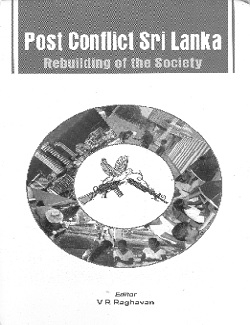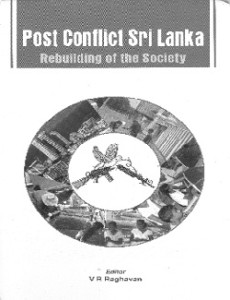Col R Hariharan
Post Conflict Sri Lanka: Rebuilding of the Society, / Edited by VR Raghavan
Sri Lanka army ended 25 years of Tamil separatist insurgency on May 19, 2009 when it defeated the Liberation Tigers of Tamil Eelam (LTTE). But the victory in what the government called the Humanitarian War (an oxymoron as no war is humanitarian) came at a colossal cost.
Three lakhs of people became destitute in the war torn Northern Province. Infrastructure and public services totally destroyed during the war are yet to be fully restored. The trauma of war is very much there in Northern Province putting strains on Sri Lankan society. And the political process to bring back the Tamils to national mainstream is not making much headway.
The book under review is a compilation of 11 research papers on managing political, socio-economic and ethnic diversity challenges faced by Sri Lanka after the war presented at a seminar organized by CSA at Colombo on conflict resolution and peace building.] The political part has some interesting papers, while socio-economic papers generally present what Sri Lanka has been doing on this front. The book opens with an introduction presenting a bird’s eye view of the contents by Brig K Srinivasan and Ms Ancy Joseph. The quality of papers included range from the excellent to the mediocre.
Professor Tissa Vitarana, Senior Minister of Sri Lanka presents an overview on nation building process. Vitarana headed the All Party Representatives Committee (APRC) constituted by President Mahinda Rajapaksa in his first tenure as President. It deliberated for three years over the complex politico-ethnic problems and made 21 recommendations accepted by 13 political parties. These recommendations were widely acclaimed by civil society for evolving a lasting solution to the ethnic confrontation in Sri Lanka. Though the President did act upon all the APRC recommendations for implementation after the war APRC report remains the only all embracing document on resolving the nation’s socio-ethnic problem.
This makes Prof Vitarana’s paper the most important one in the book. Prof Vitarana takes a pragmatic look at the road blocks to the ethnic reconciliation process. The reality is the SLFP-Sinhala Buddhist lobby is holding two-thirds majority in parliament, a federal solution is unfeasible. However, the professor argues that even in unitary solution it was possible to meet most of the aspirations of Tamil minority. However, the Professor argues that the APRC’s recommendations be the starting point for the PSC deliberations may well achieve this.
Ambassador G Parthasarthy’s ‘Emerging trends in Indian regional policies and approach to relations with Sri Lanka’ provides a regional relevance to the post-conflict analysis of Sri Lanka. While it gives a compact survey of India’s worldview shaping its regional policy, the author’s treatment of India’s relations with Sri Lanka could have focused more on dilemmas faced by India due to the tardy response of Sri Lanka to Indian concerns to relate the paper better to the theme of the book.
The scholarly papers on ethnic diversity by N. Manoharan and Gnana Moonesinghe provide a good understanding of the ethnic complexity faced by Sri Lanka in particular. Readers would find it useful to read them as they provide the backdrop for issues discussed in other papers.
N. Selvakumaran’s paper on ‘Linguistic Challenge’ presents valuable insights into the evolution of language policy in Sri Lanka. However, l have my reservations on the coinage ‘linguistic challenge’ as language policy has been used as a political tool of ethnic politics. Though much has been written on language issue in Sri Lanka I wonder whether any empirical study has been carried out by policy makers to understand its impact on society. One hopes Sri Lanka’s recently announced tri-lingual policy would remove language as a factor in politics and make it a tool for building ethnic understanding.
Rajiva Wijesinha is familiar figure in his role as presidential advisor on reconciliation. He had been writing and speaking on the Sri Lanka perspective on reconciliation issues in many forums. Considering this, his paper on political challenges falls short of expectation. If he had included the three areas for action he had recommended in the draft National Policy on Reconciliation for action, it would have added to the value of the paper. The three action areas are: recovery from the ravages of conflict and equitable development; political participation and administrative accountability; and ensuring justice and truth and understanding to ensure restitution not retribution. The three-point concept of governance touched upon in the summing up is too brief; it kindles curiosity without satisfying the reader.
Wijesinha’s observation “government concentrates more on telling a story that would translate into electoral successes and did not concentrate on winning hearts and minds” sums up the Sri Lanka ruling coalition’s attitudinal problem in dealing with post-conflict management.
The Tamil perspective presented by Kandiah Visveswaran, political science scholar, is short on analysis and long on description. While presenting the Tamil viewpoint, he has allowed emotion to overtake critical analysis. Roughly one third of the whole paper has focused on how historically Sinhala’s have tried to deprive the rights of Tamil nation. The rest of the paper is a long chronicle of ‘Sinhala government’s calculated approach’ to subjugate Tamils in the post-conflict period, without constructive suggestions from the Tamil perspective.
The author in his attempt to vilify Sinhala-Buddhists has justified acts of violence and terrorism of the LTTE saying that the presence of Tamil armed resistance was able to prevent access to large part of the Tamil homeland and obscured structural and cultural violence against Tamils. Actually LTTE was on the offensive to carve out an independent Tamil Eelam and not fighting a defensive battle. It eliminated more Tamil political leaders than Sri Lanka State. LTTE’s assassinations and suicide bombings killing scores of innocent civilians during the ceasefire period from 2002 to 2005 ensured the disintegration of the peace process of 2002.
However, the author has chosen to wish away the negative impact of LTTE’s provocative killings which gave a lease of life to Sinhala-Buddhist chauvinism after people voted for peace and looked forward to the success of the peace process.
It is true Sri Lanka’s reconstruction effort has serious flaws and its efforts at political reconciliation are tardy. But to conclude that the ‘Sinhala polity is not ready to share power because power sharing would seriously hamper the once hidden agenda, open at present – that is to establish Sri Lanka as a pan-Sinhala state’ as the author has done will be trivialising the huge sacrifices Tamils have made for nearly 60 years of their political struggle. The political struggle interrupted by 25 years of insurgency that has once again resumed after the war. The only option for Tamils is to strengthen the political process to achieve their aims as there is enough global sympathy for them after the war.
The Muslim minority of Sri Lanka has been caught between the LTTE’s armed struggle and the majority Sinhala response to Tamil militancy. So it is interesting to note the national focus of Ambassador Javid Yusuf’s piece, ‘A national perspective through Muslim eyes’ in contrast to the Tamil perspective. He focuses on the need for translating the post war achievements into meaningful and equitable benefit for ordinary man’s day to day life. It will be useful for Tamil community to heed his suggestion to introspect seriously on their role in post war Sri Lanka to decide upon their strategies.
Yusuf’s plea for the leadership of TNA to augment its moral strength by publicly declaring the LTTE’s armed struggle was a mistake is a bitter prescription. Doe the TNA leadership has the moral courage to do so, after years of living in the reflected glory of the LTTE? He is critical of the Muslim leadership for making no attempt to explain their strategies in contrast to those adopted by Tamils as a result of which they were considered as undermining the Tamil cause. He also takes to task the community’s political leadership for ignoring the sufferings of Muslim community for their personal benefit.
The book is very well edited by Lt Gen (retd.) VR Raghavan and its production values are of a high order. Overall the book fulfills its aim of providing an understanding the complexities of post-war rebuilding of society in Sri Lanka. Research scholars, think tanks and policy makers will find the book very useful.
Courtesy: The Book Review, Vol XXXVI Number 9, September 2012
Vij Books, New Delhi, 2012, pp 194, Rs 850
DBS

